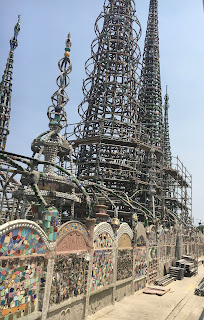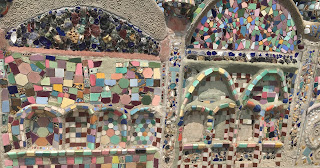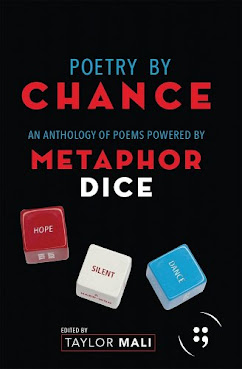The calendar says the first day of fall is September 22, but we all know summer ends the first day of school. Here, that is August 6. Right on schedule, the temperature ratcheted up to 95 plus. Kids at bus stops, melting into the sidewalk at 7 am? So wrong. So unseasonal. Like a street corner Santa in July.
Summer is pure pleasure for me...as long as there is air conditioning. Summer brings out my latent optimism...partially because I am teaching Young Writer's Camps (pure joy), and partially because the skies are mostly sunny. The laid back schedule of summer allows me to indulge in a trip to someplace I've always wanted to go. Sort of like a bucket list, except I'm not organized enough to keep an actual list.
So this summer, we went to Watts.
Yep,
that Watts. The one that those of us of a certain age, watched burn in the riots of 1965.
 |
| My daughter, me and the Towers. |
For me, Watts means the Watts Towers. Somewhere in my childhood (maybe an article in
Life magazine?) I learned about this magnificent yet quirky installation, built over the course of 34 years. Built by one Sam Rodia. Just Sam. Nobody else.
There are whole volumes dedicated to the "meaning" and "form" of the Towers. Finding out about Sam Rodia, not so easy. Here is what we don't know about Sam: his real name (variously listed as Sam, Simon and Don; it changed with every census), his actual age(ditto),when he immigrated from Italy (he does not appear on any Ellis Island ship roster), what he did before 1921( from the records, he wandered up and down the West Coast, working as a day laborer, marrying and divorcing at least three women, with whom he had at least two children..that the state of California knew about.) Sam-Simon-Don was a recluse who wasn't much of a talker. Interviewed later in life, he would toss out whatever answer came to him first, forgetting what he'd said previously. Or maybe he just didn't care.
Here's what we know for sure. In 1921, when he was 42 (maybe),Sam bought a triangle-shaped lot at the end of a 107th street in Watts. Back then, Watts was a bedroom suburb of LA. surrounded by truck farms owned by Japanese families. Watts itself was a mixture of immigrant groups, eventually joined by African-Americans, seeking employment in the factories that were taking over the farm lands. Watts was a transportation hub for both rail shipping and the Red Line commuter trolleys that ran between Long Beach and Los Angeles. The railroads ran right along the northern edge of Sam's property.
After his day job in construction, Sam came home and began to build on his pie shaped bit of land. Sam, who had no training in design or architecture, was constructing
something out of wire and rebar and discarded steel rails he picked up along the railroad beds. Sam worked without welding or nails. Without scaffolding or plans. He used the railroad tracks to bend steel into the shape he needed. He worked on his own time, using his own money.
"What are you building, Sam?" the neighbors asked.
"I'm gonna build something big," he'd say. The neighbors knew Sam well enough to not ask questions, so they just watched. They watched for 34 years as Sam built a mosaic wall around the whole property. Not a plain old wall, but one with a scalloped top. Did the scallops represent sea waves, waves that would take him home to Italy? Sam never said.
 |
| The walls and towers |
Within those walls, Sam erected three towers, the tallest of which was 99 feet. Sam was only four foot ten, so the concrete enforced ribs of the towers were close together, as far apart as a man of his stature could reach. When the towers grew beyond his tallest ladder, he climbed the lower rungs of his tower, higher and higher, adding increasingly small layers until he judged the tower "big enough." He covered his metal skeleton with a thin shell of concrete. He ornamented every inch of the concrete with whatever he found in his neighborhood.
Here is what he used: Seashells, abalone and clam shells. Bits of mirror. Rocks, large and small. Remnants of linoleum and marble. Broken dishes and tiles, rejects from the local pottery factories. Glass bottles the neighborhood children brought him: green soda, blue Milk of Magnesia, brown beer bottles and Chlorox jugs. Glass telephone line insulators. . He embedded his "jewels" into the concrete when it reached the right consistency not too wet or the pieces would sink and be covered, nor too dry, lest the elements would not set firmly and fall off.
 |
| Walls |
Sam worked without a safety belt. With his gas fitters pliers, he shaped the glass in the fire he kept going at the back of the property. He had a tile cutter. These were his only tools.
Sam worked and worked. For thirty four years. Then one day when he was 75 (or 73 or 78), he climbed off his tower and said, "I'm done." Some of the work wasn't finished, but Sam was. He sold the property to his neighbors for 200 dollars (they wanted to open a taco stand), packed his suitcase and moved to Martinez near San Francisco, where is sister lived. He lived in Martinez for the last ten years of his life, dying only a week before the Watts Riots.
He never saw the Towers again.
From across the street, the structures make a lovely multicolored whole, glass and tile sparkling in the sun. But closer, you can see the individual elements. Plate halves. Seven-Up and Canada Dry bottles. Rows of seashells. A patchwork of Arts-and-Crafts style tiles, the same pattern as some in the Smithsonian collection.
The Towers are currently under restoration, so the whole area was fenced off. I can only imagine what it would be like to wander the lot; there is a fish pond, a gazebo, the "ship of Marco Polo", the archway of Sam's house (the original burned in the late 50's after Sam had moved away) These pictures were taken by sticking my phone through the fence rails (probably illegal). I wondered at how Sam had created such an amazing work of art, using nothing but discards, and his own imagination and hard work. (You bet I'm coming back when those fences come down.)
 |
| My grandmother's bowl--yellow at the top right of arch |
Then, on my way to the car, something ornamenting an archway caught my eye. Two bowl halves, decorated with daisies. That was
my bowl! Or rather, it was my Grandmother Smith's Hull mixing bowl that had then been Mom's, then mine. And now here was its broken twin, gleaming on Sam's archway.
Sam did what we all do as writers (if on a somewhat grander scale). He took the detritus of every day life and fashioned it into a whole, unique entity, something whole Sam could've built. We take the odds and ends of our lives, and shape them into stories, without help, using only our imaginations and our gut feelings. We also work without a safety belt or net. We climb our story towers, working as far as we can reach, until something tells us we're done.
 |
| The bowl |
Why do we do this?
Why did Sam build the Towers? Was he constructing his own little town? Was he building the "ship of Marco Polo",pointed toward Italy, to take him home? These were all things Rodia had told reporters over the years. Does it really matter? The one statement that Sam never varied from is good enough for me.
"I'm gonna build something big."
And so are we.
...And we have a winner!!!
We are pleased to announce that Geri G. is the winner of our giveaway of HP? Who's He? by Patricia Karwatowicz!
For more about Sam Rodia and The Watts Towers here are some wonderful children's books:
The Wonderful Towers of Watts by Patricia Zelver, Boyds Mills, 2005
Dream Something Big by Diana Hutts Aston, Dial, 2011



 In between promotion and editing, I did find time for some fun, including going on a Troll Hunt at the Morton Arboretum (with my husband John, whom you can see in the photo standing beside Joe the Guardian)
In between promotion and editing, I did find time for some fun, including going on a Troll Hunt at the Morton Arboretum (with my husband John, whom you can see in the photo standing beside Joe the Guardian)

























